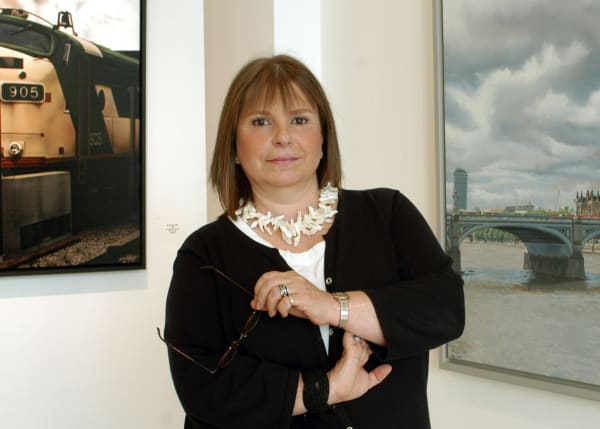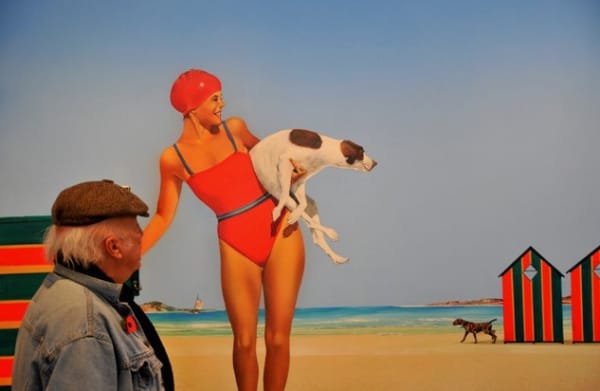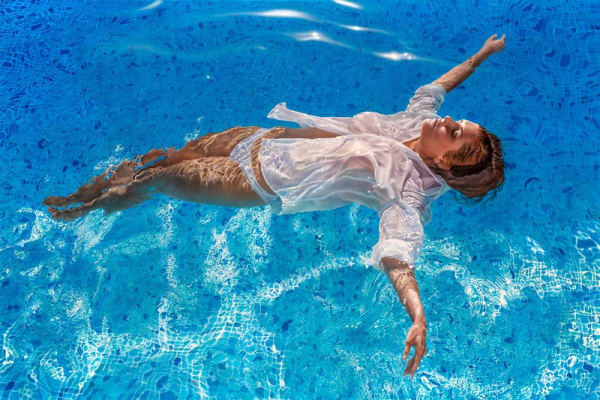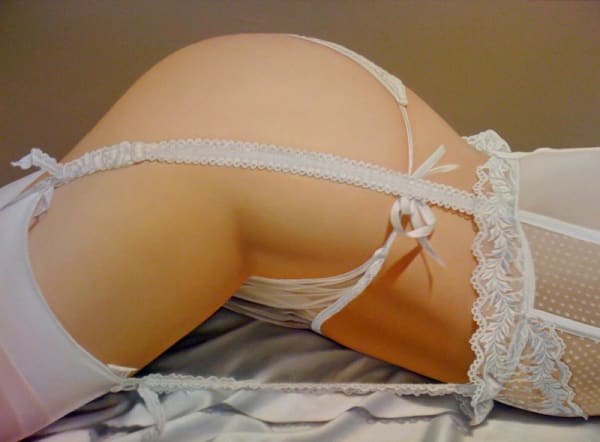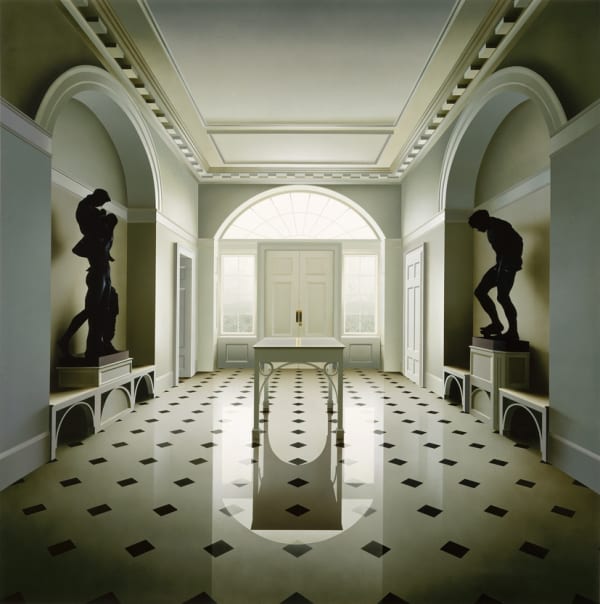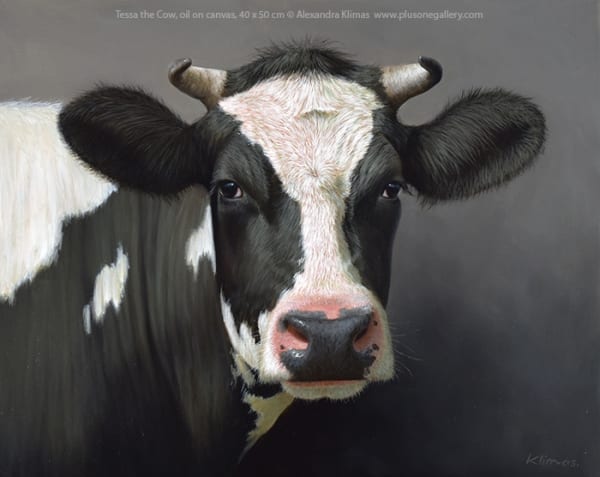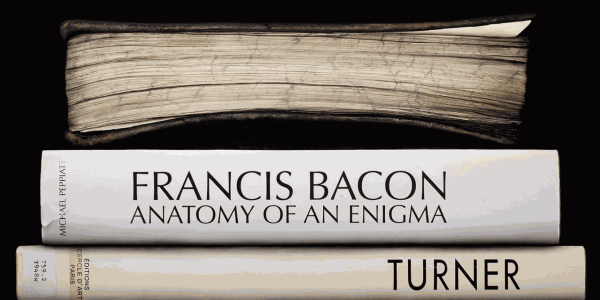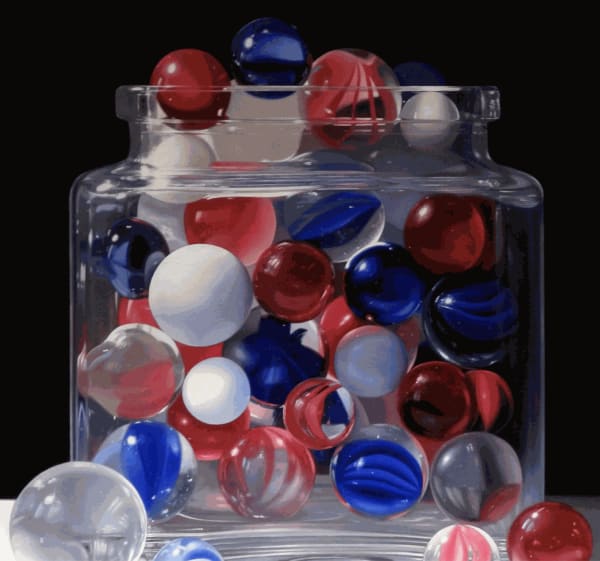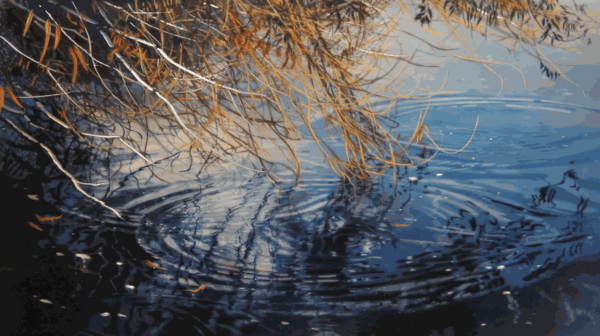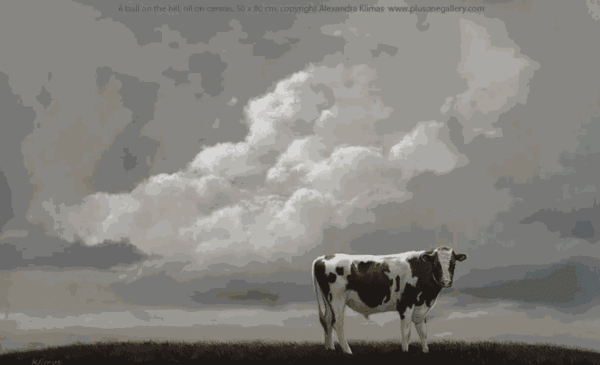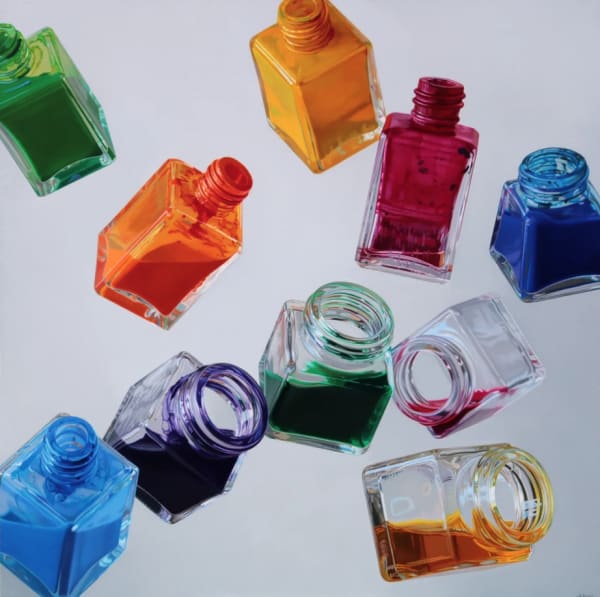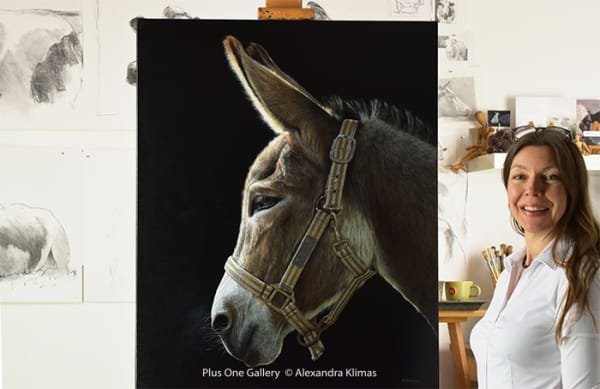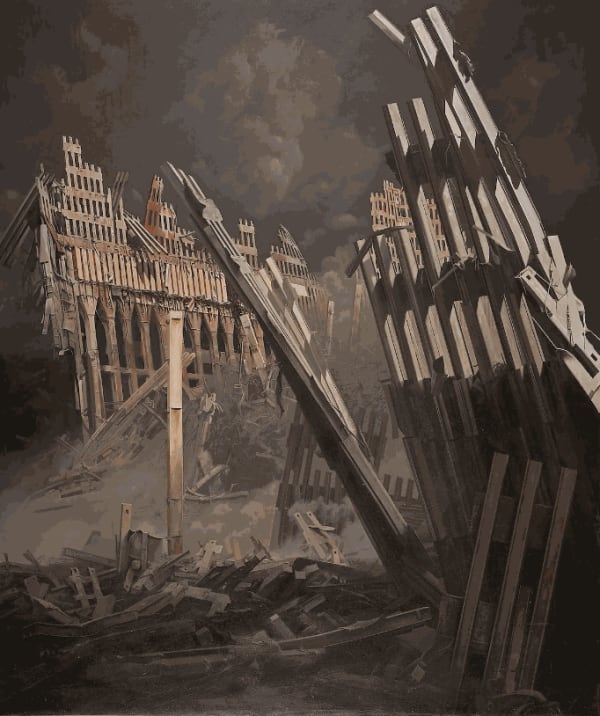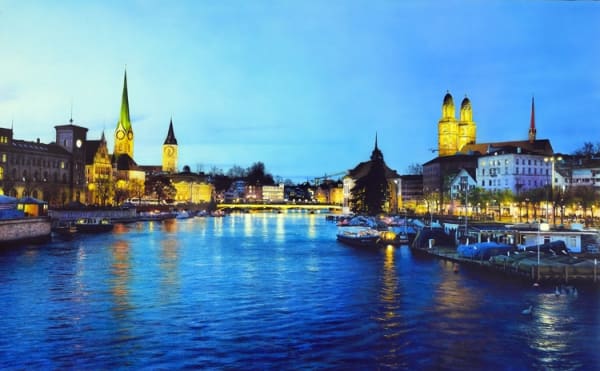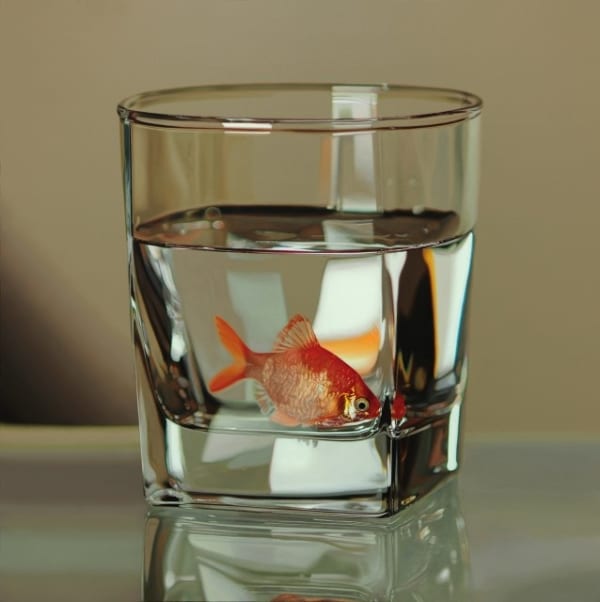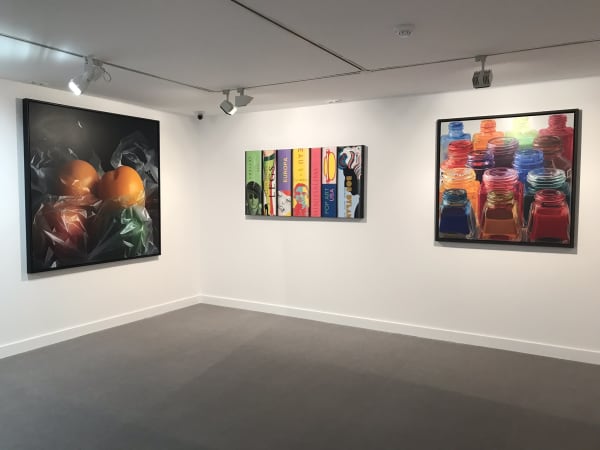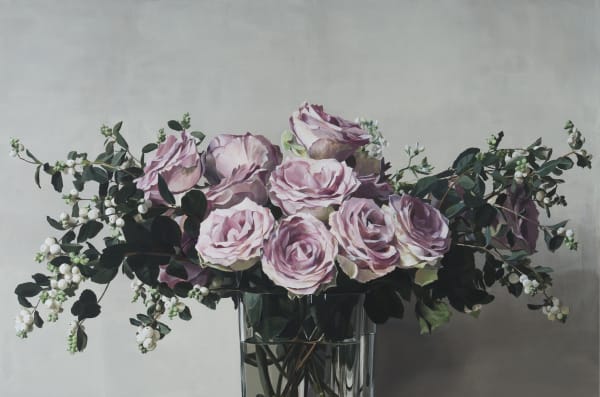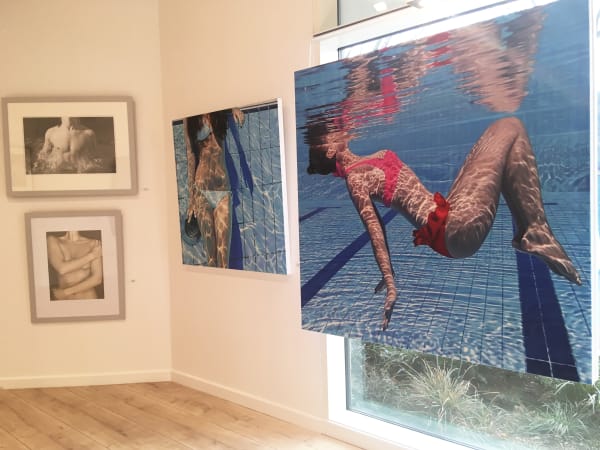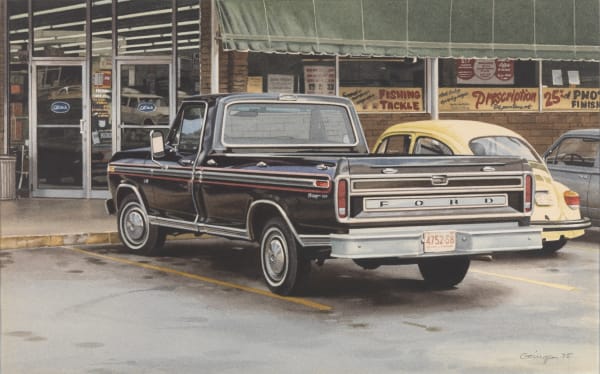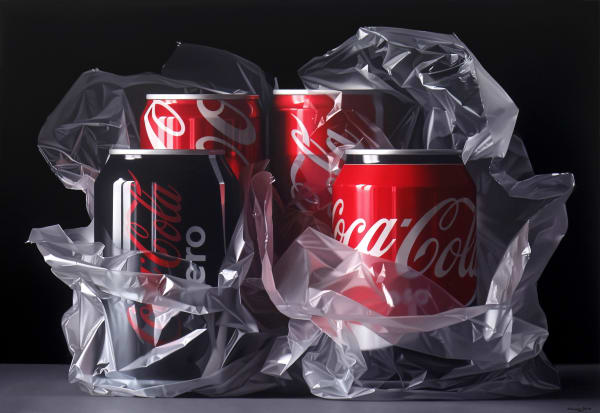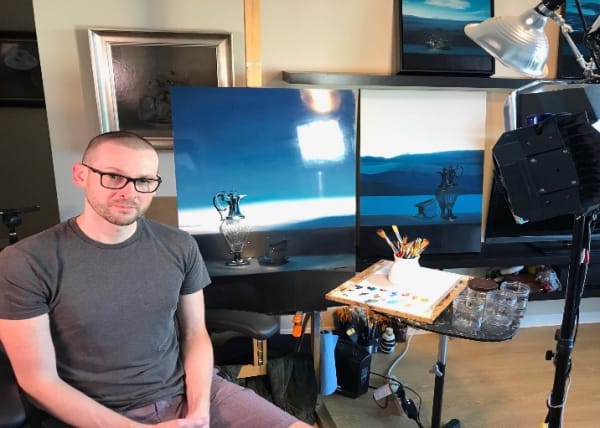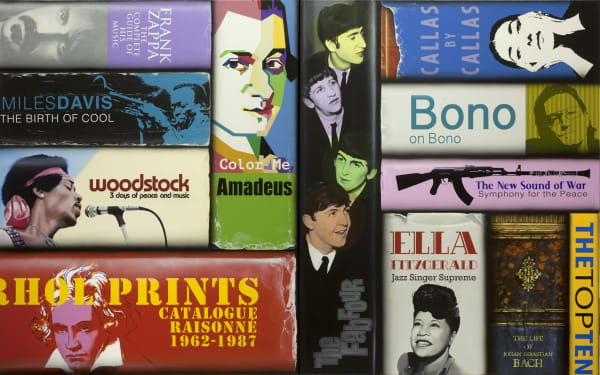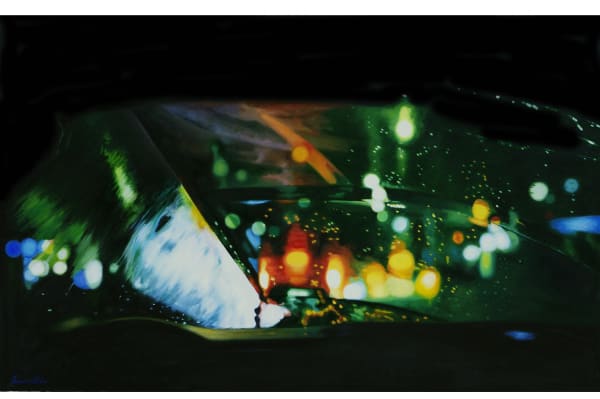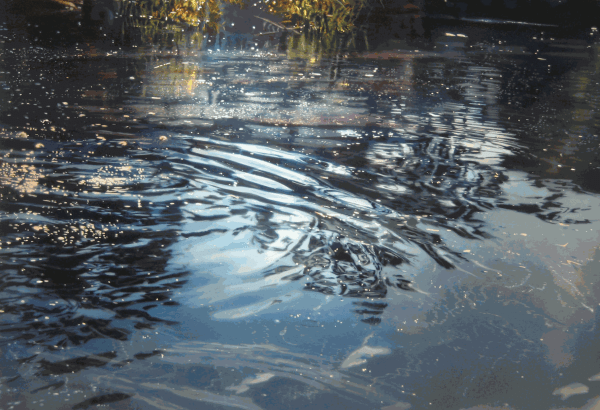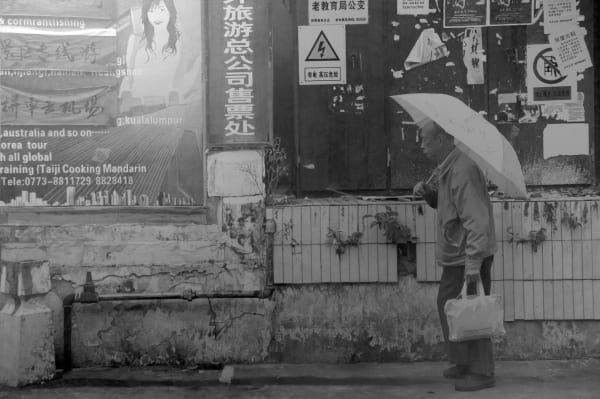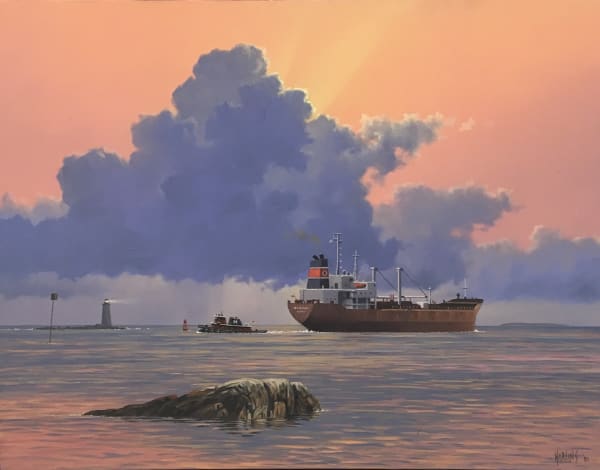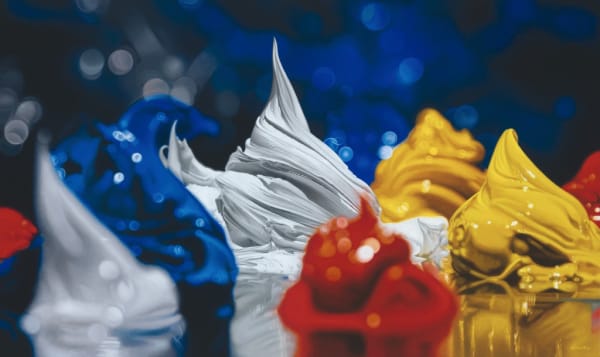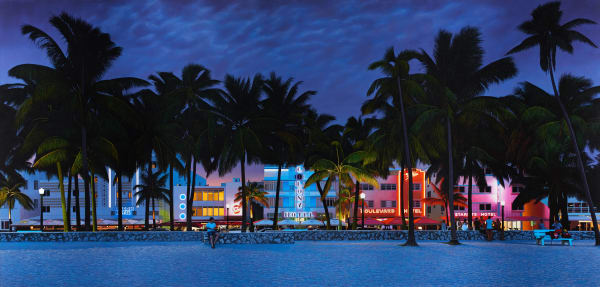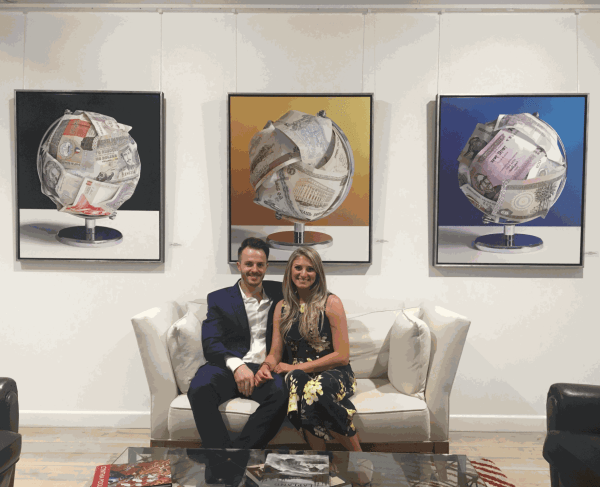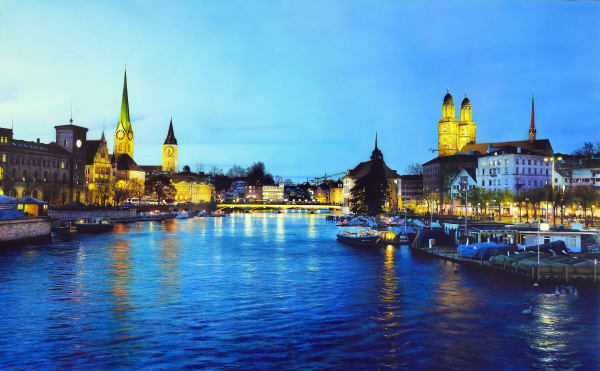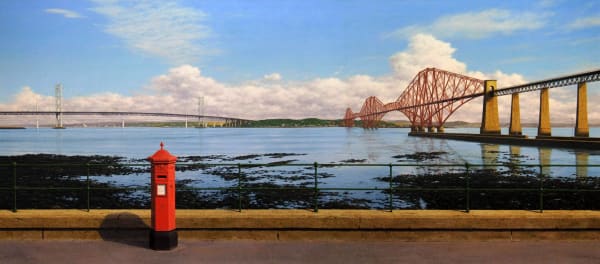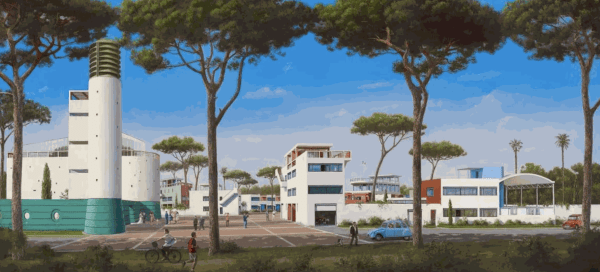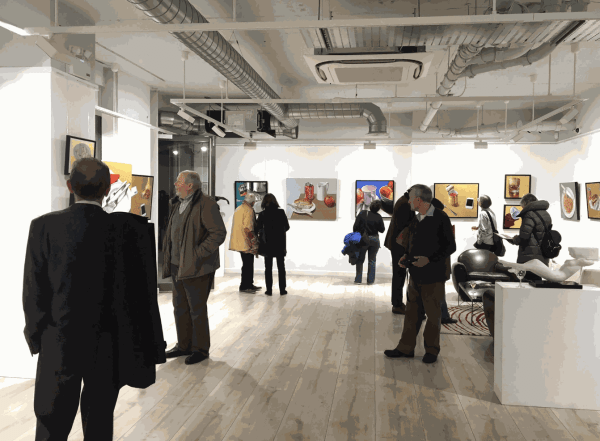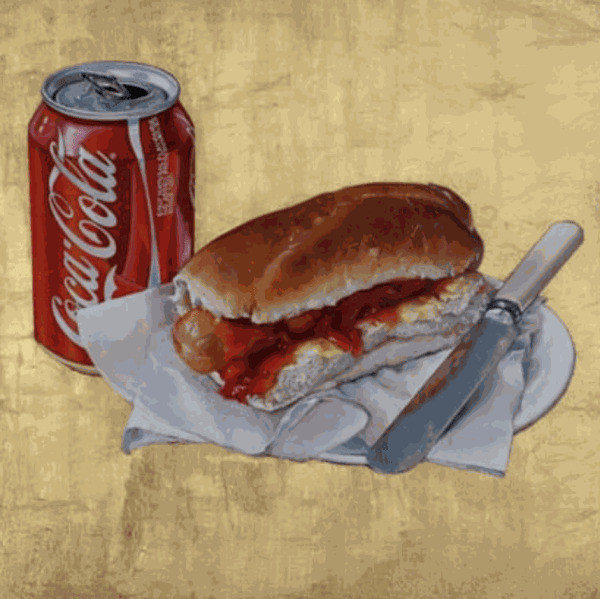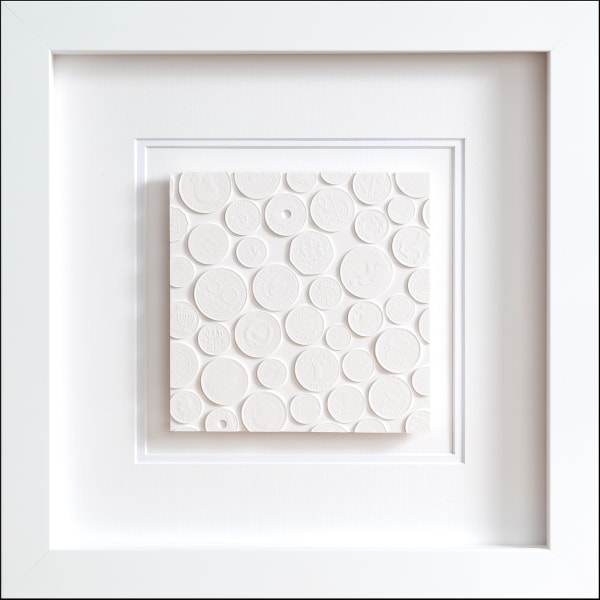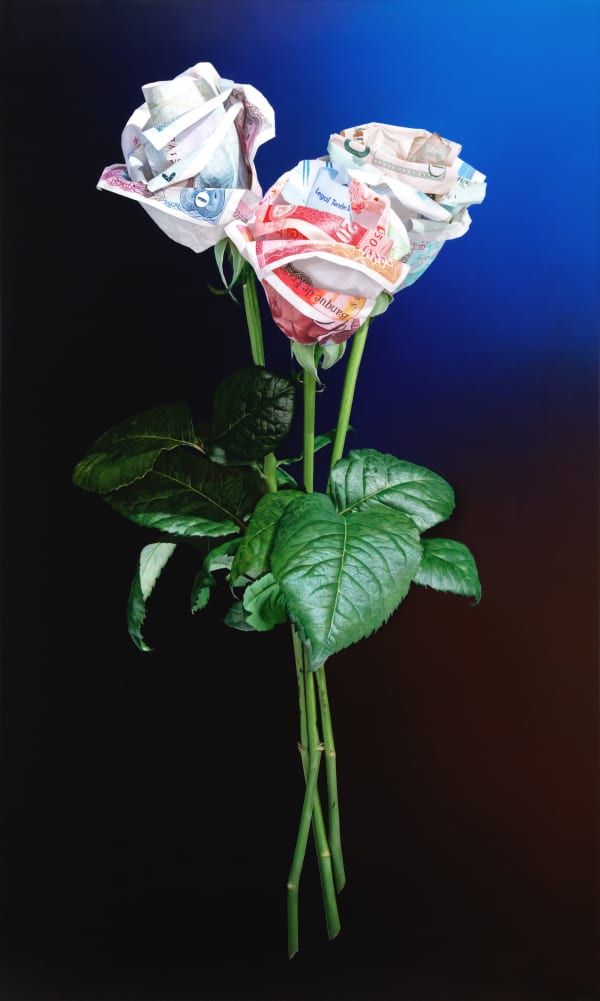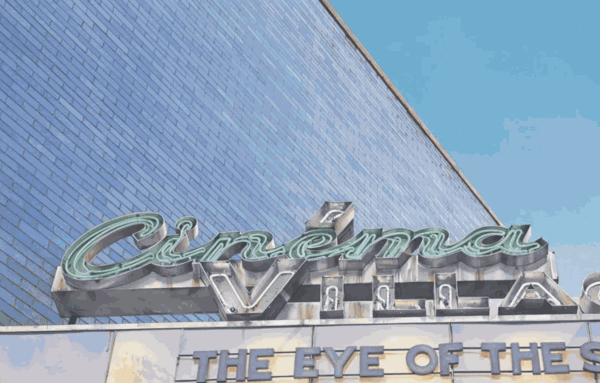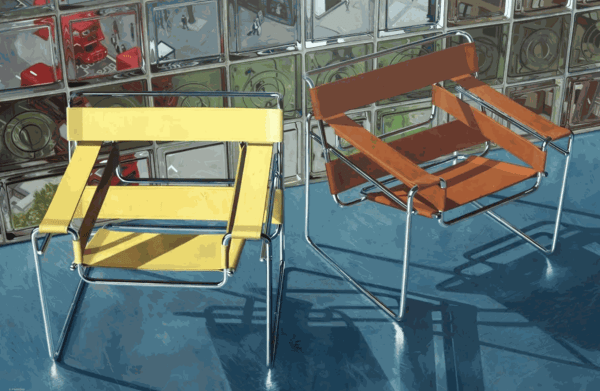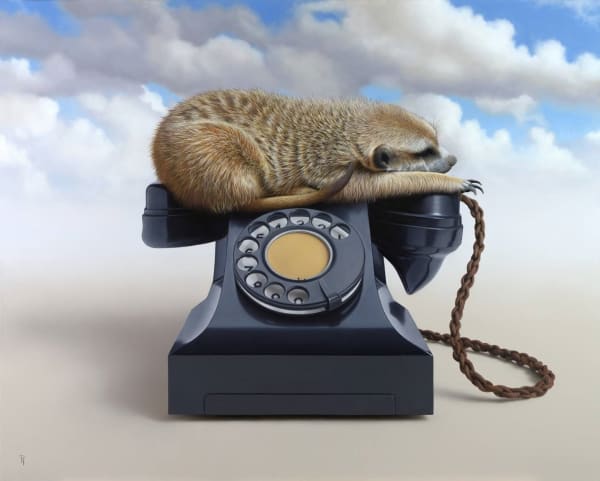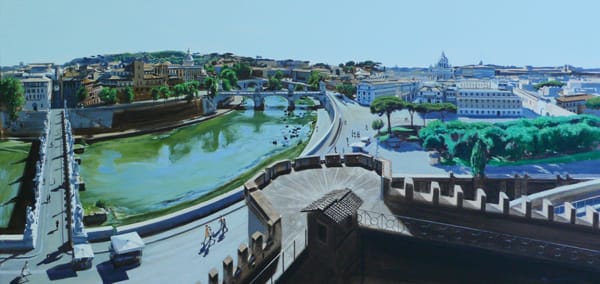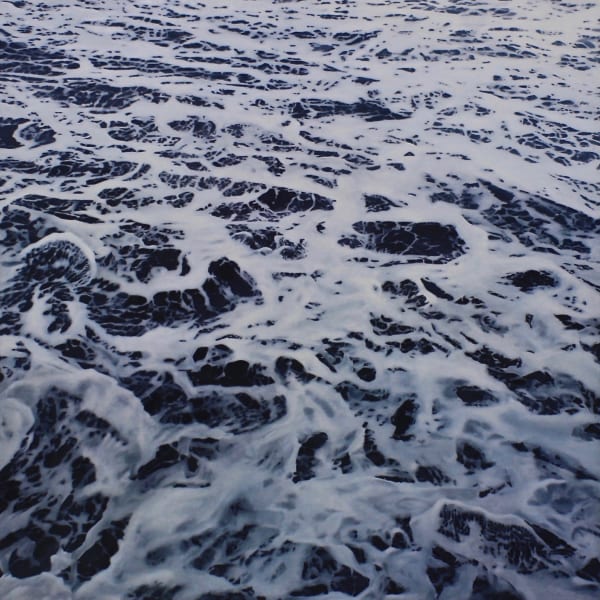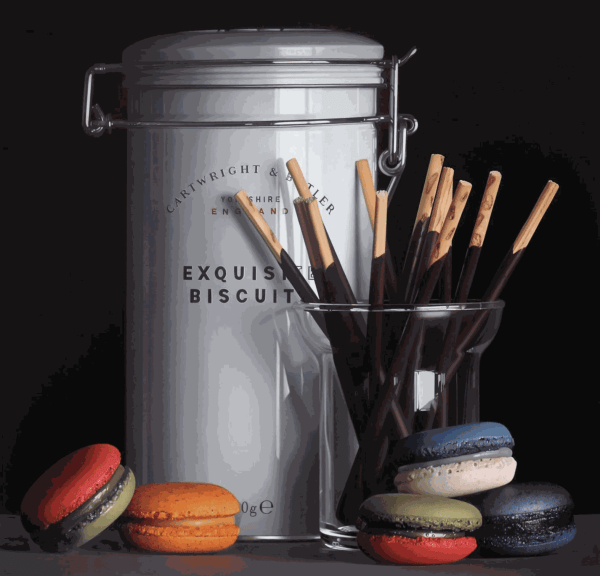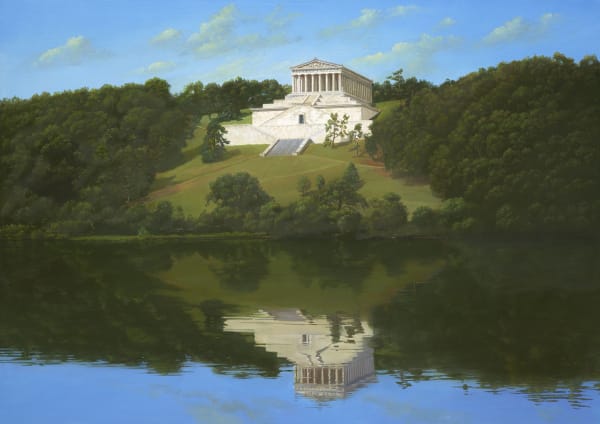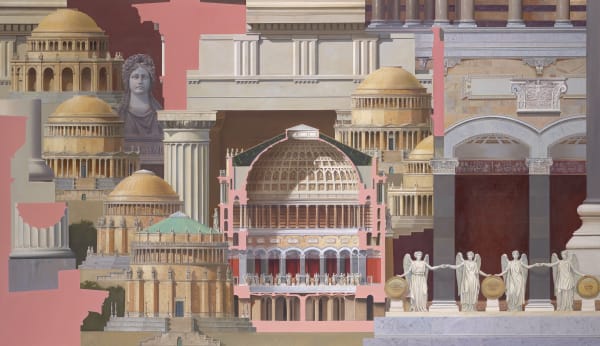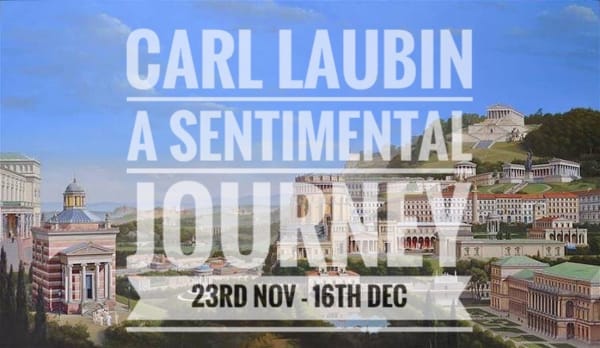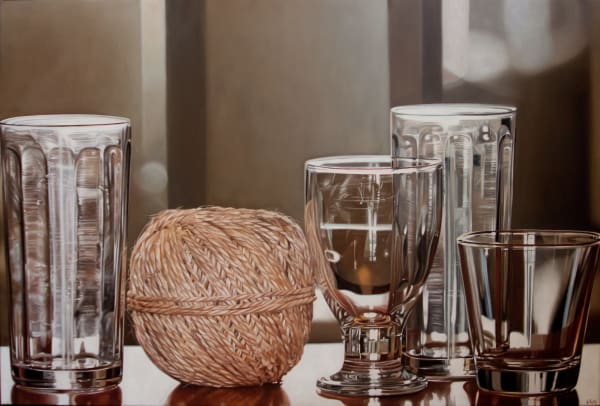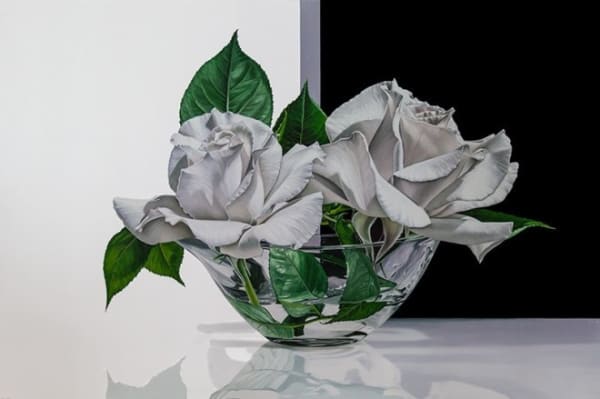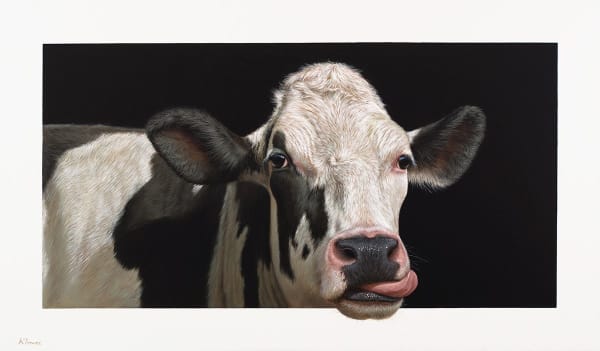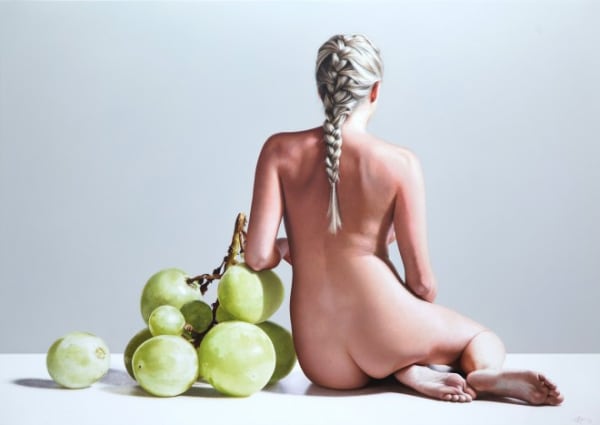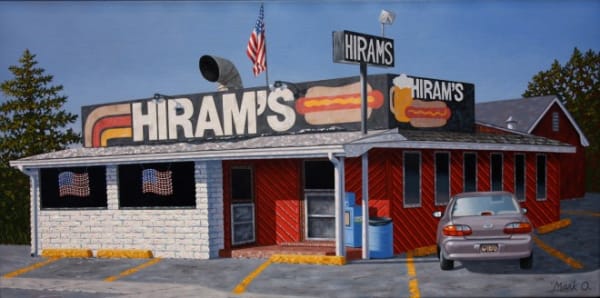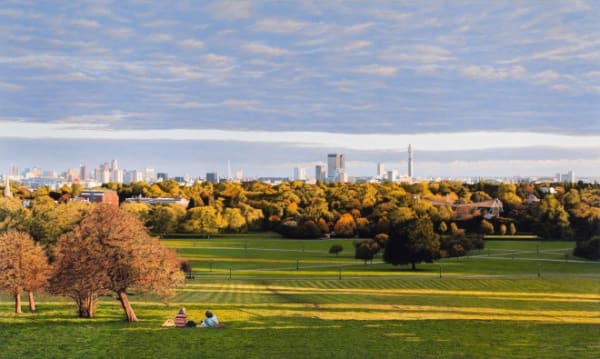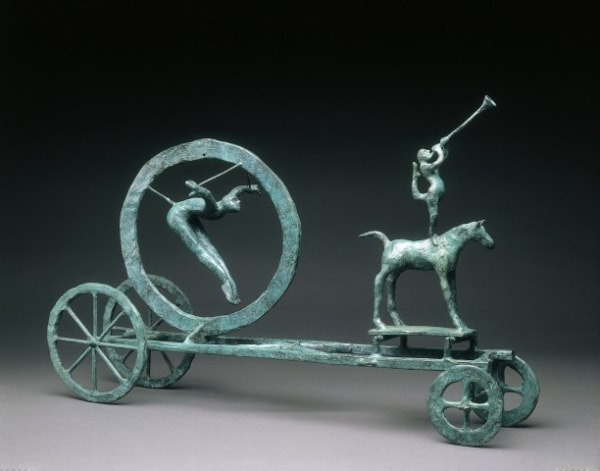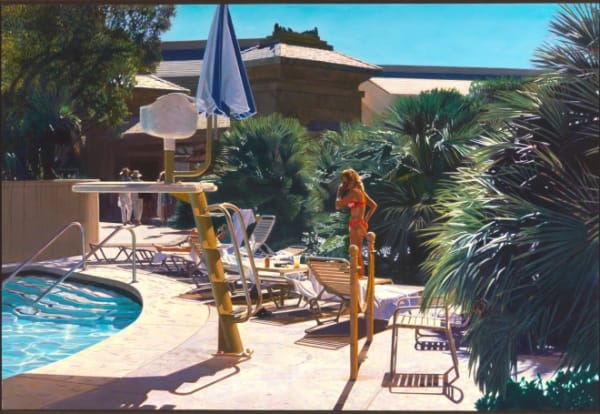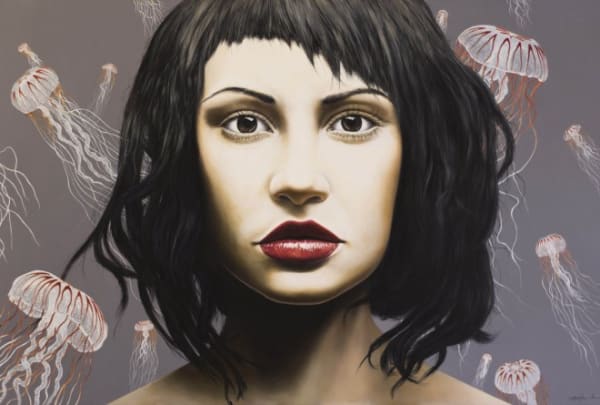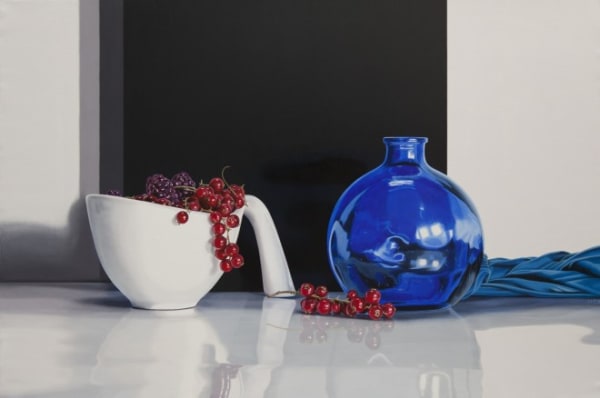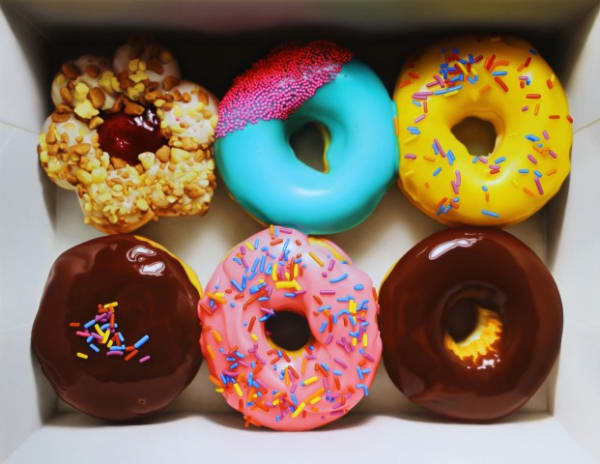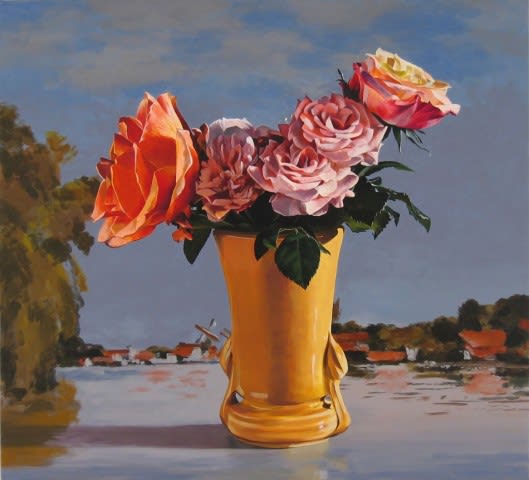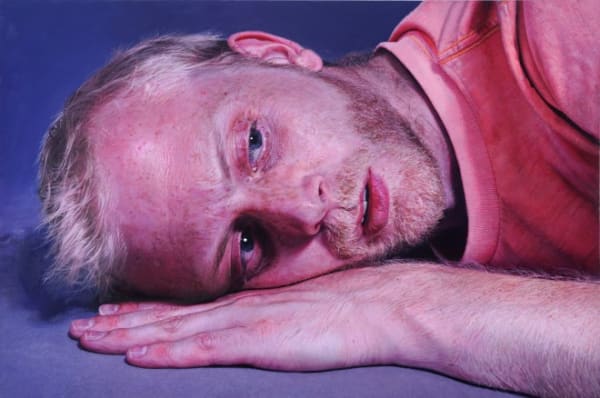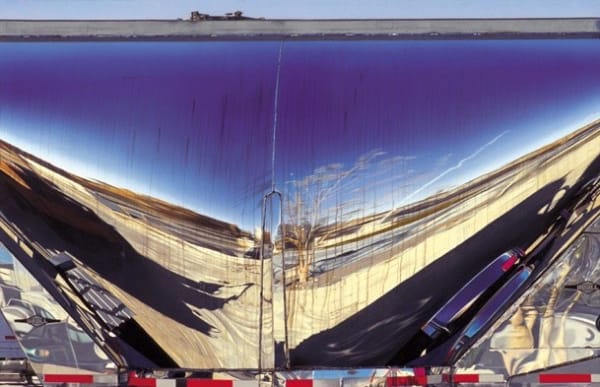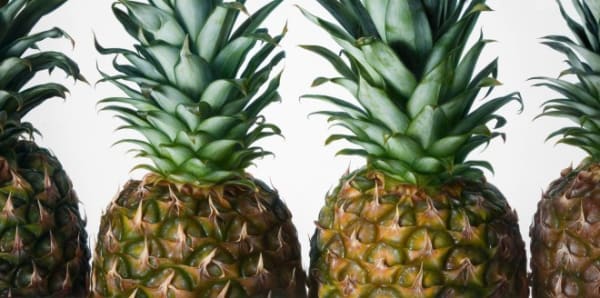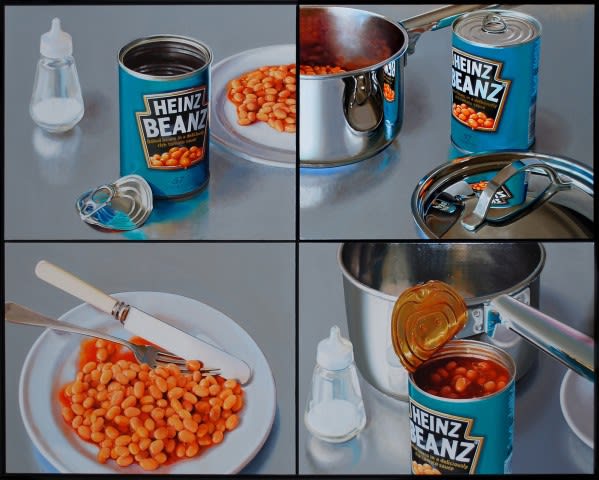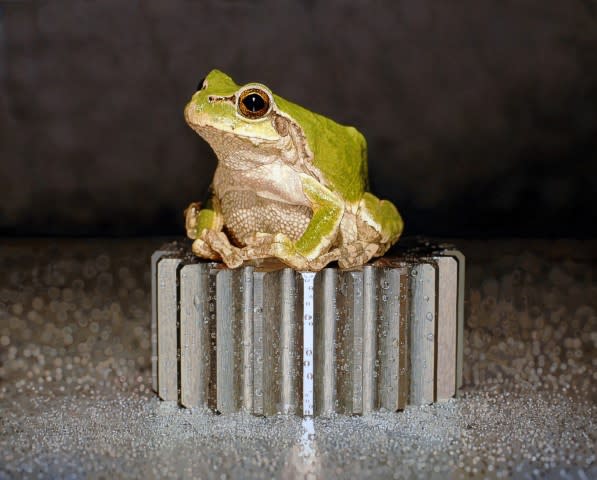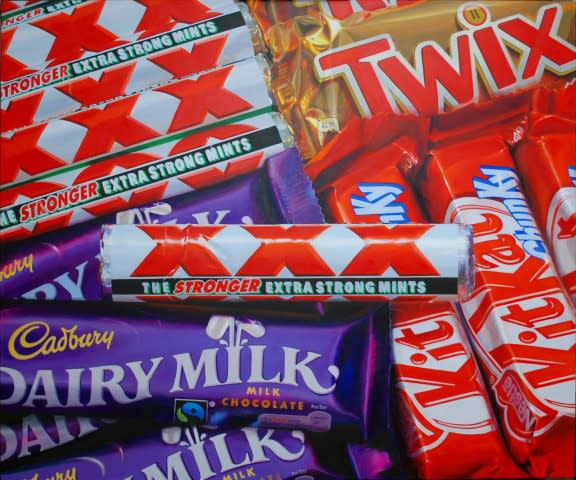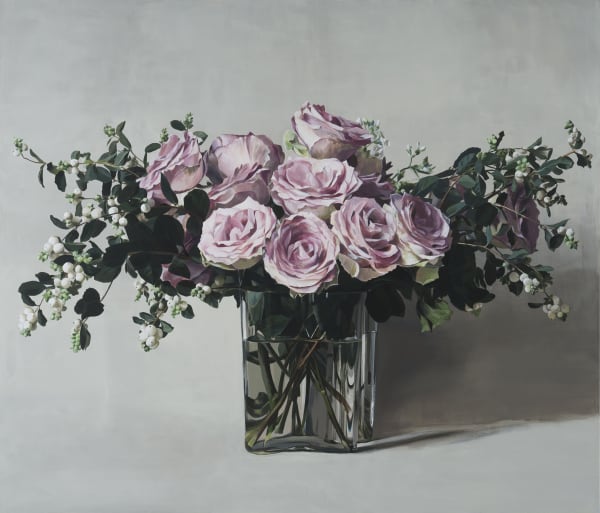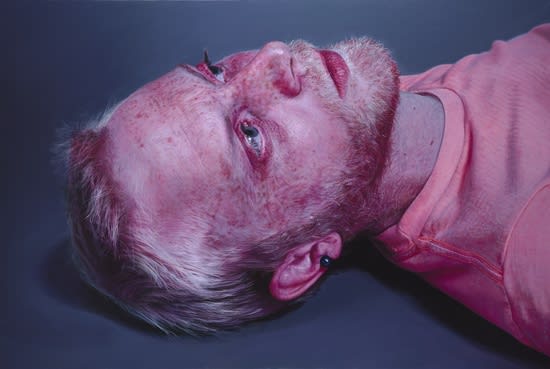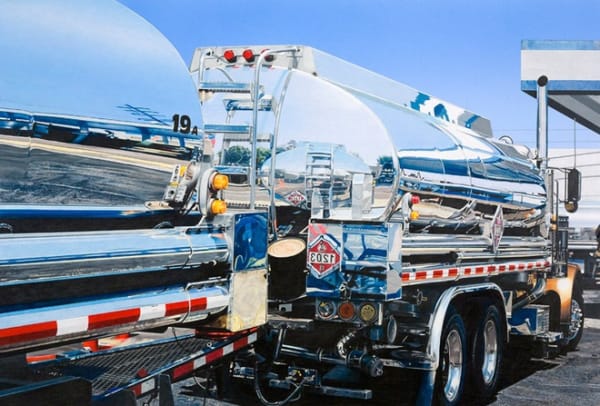
Hyperrealism is defined as a figurative art form of superlative precision and exceptional clarity. It is the most direct visual expression of art omitting the literal understanding of both abstract and conceptual ideologies, focuses on the outstanding skill of creating such a heightened replication and intense realism which is almost unbelievable. It has proved to be an optimistic art that asserts humanities ability to create beautiful compositions and invent wonderful visions. In short, this is an art form of commitment, passion and self-expression.
The end of the 19th century saw the birth of Photography and the effect it had on the painter, whose skills became redundant in a time when the main purpose of art was to document life, this opened new opportunities for artists as they became free to pursue other possibilities. The initial genre to directly employ the use of photography through commercial advertisements and packaging was Pop Art, followed closely by the Photorealist artists which recreated the photograph in their paintings utilising the photograph as the only reference point and replicated it to the point of an exact rendition of the photo including any photographic effects and defects. The term hyper-realism appeared in the early 1970s to describe a resurgence of particularly high-fidelity realism in painting and in sculptures. It was the natural progression stemming from the likes of Photorealism and Pop Art but without the confines of both movements.
Hyperrealism is a distinctly modern movement with obvious antecedents in Photorealism, along with Pop Art and Precisionism. Photorealism was the total rendition and recreation of its subject, taking realism to its literal conclusion. Hyperrealism, by contrast uses the original photograph as a starting point rather than the end goal. Hyperrealism focuses on the visual reality and beyond, standing as a strong alternative to the conceptual art which has been so dominant within contemporary art practice, it satisfies the visual needs of the viewer. Artists of this genre examine and respond to reality in a very specific way, acknowledging the camera as a tool, and utilising the possibilities it offers to capture a moment in time, and the magic of that instance. The attention to detail, immense precision and amount of skill that goes into these works of art is reflected through the monumentality and diverse subject matter present in the paintings. At times, it can prove almost beyond visual ability. There are no brush marks or textures between the image and the viewer, and a direct and precise image is conveyed without the imposition of the artist’s personality in the form of gestures.
Hyperrealism, coloured by a European sensibility and depth of Art History, has different qualities to much that has been made in America. The scene has become more diverse in both where it is exhibited and in style and its increased visibility within the art market is proving to be influential on younger artists. There is an international dialogue and followers of leading artists, all of which adds to the momentum, and the notion of a movement. The movement attempts a realism beyond that of the source: more vivid, more emotive, sharper, brighter. It is selective when it comes to the characteristics of the source photographs, and more responsive, more personal, more flexible than Photorealism. The artists in this movement are not afraid to portray more picturesque compositions whereas Photorealist’s depict a more unequivocal rendition of the photograph. Although Hyperrealism is clearly aided by the camera, these artists push the boundaries: the camera is just another tool as is a brush or an easel. The development in digital technology allows these artists to not only document minute details but also to manipulate the image using computer programs such as Photoshop creating artworks which appear more real than the real thing once painted on their canvases.
As we live in a world in which everything around us is evolving, we are in a constant state of change and art is no exception. Since the ancient Greeks, intense realism has been an aspiration of Western art and Hyperrealism is a modern response to these figurative traditions. The hyperrealists of today are documenting this almost daily evolution within our society through the artworks they create. One clear example is Tom Martin’s portrayal of the economic breakdown within our modern world as seen in Collateral II. The way we communicate is inextricably linked with the photograph, the reproduced image and the moving picture, and our personal and cultural sensibility is defined by the way we interact with these images. Therefore, it is no surprise that as human beings we can react, assimilate and appreciate Hyperrealist art.

Tom Martin
Collateral II, 2017
Acrylic on aluminium composite panel, 105 x 115 cm
Broadly speaking within the Hyperrealist movement there are three distinct categories that its practitioners work within: Landscape/ Urban Landscape, Still Life and Portrait/ Human Figure. Each artist’s way of arriving at a painting’s starting point is as unique as the painting itself. This disparate group of artists bring diverse and interesting subject matters to the movement, ranging from Francois Chartier’s monumental still lifes such as Who Wants to Live Forever to Paint in my Head, Eloy Morales' interpretation of modern portraiture. John Salt’s photorealistic depiction of a vintage and decaying American urban landscape shows the viewer the other side of the “American Dream”, as seen in Trailer with Rocking Horse.
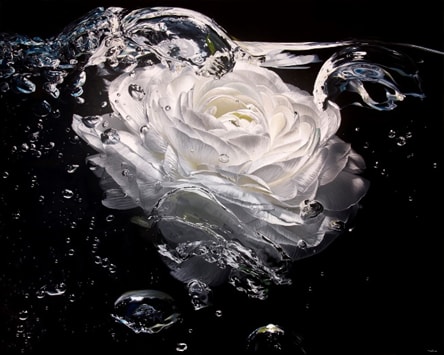

Francois Chartier Eloy Morales
Who Wants to Live Forever, 2022 Paint in my Head, 2023
Oil on canvas, 122 x 153 cm Oil on canvas, 120 x 120 cm
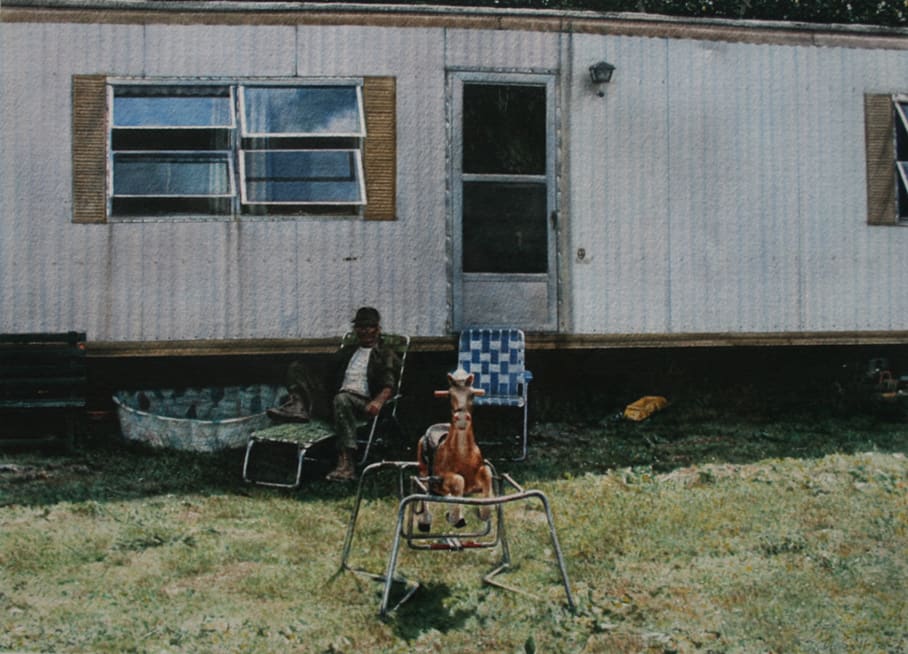
John Salt
Trailer with Rocking Horse,1974–75
Watercolour on paper, 30 × 42 cm
If we take the three main areas within the genre it is clear to see that they are all acutely defined by different characteristics. Monumentality plays a significant role in the execution of still life paintings and this is apparent in Pedro Campos’ A Hot Day and Vanitas 15.09.28 History of Music by Paul Beliveau. The artists working within this field often favour a combination of both monumental scale and extreme close-ups which delivers a surrealist feel to the final composition.

Pedro Campos Paul Beliveau
A Hot Day, 2008 Vanitas 15.09.28 History of Music, 2015
Oil on canvas, 150 × 150 cm Acrylic on canvas, 152 x 244 cm
A characteristic visible within the Landscape and Urban Landscape paintings is the use of reflection, where we are presented with two images; one real and the other reflected on a variety of surfaces such as water, glass and chrome. Sometimes two or three depictions are presented in just one painting. Both Christian Marsh's painting Inner-City Tranquility and David T. Kessler’s waterscape Evening Balance portray these qualities.
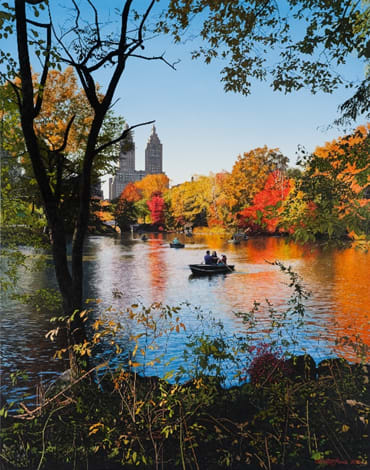
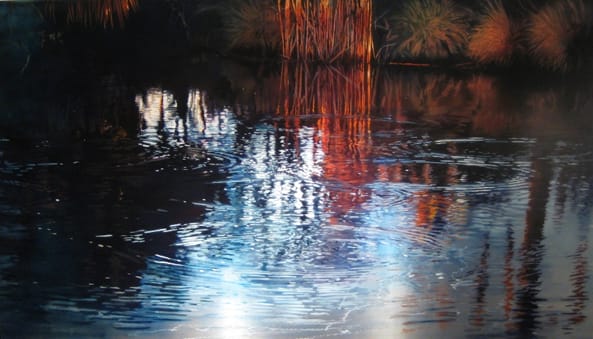
Christian Marsh David T. Kessler
Inner-City Tranuility, 2013 Evening Balance, 2012
Oil on linen, 95 x 120 cm Acrylic on panel, 122 x 213.5 cm
Portraits have dramatically developed over the years, as the portrait artists of today are using their paintings not only to focus on their subject but depicting social themes as well, Drawing from Detroit by Paul Cadden is a perfect example of this contemporary condition.
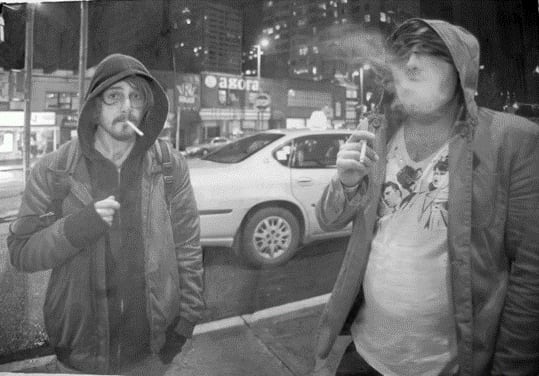

Paul Cadden Alexandra Klimas
Drawing from Detroit, 2010 Lora the Cow, 2023
Pencil on paper, 58.5 × 84 cm Oil on canvas, 80 x 60 cm
A technique which runs through the three categories is that there are no brush marks or textures present within these paintings as the Hyperrealists often see this as a way of covering imperfections. Alexandra Klimas’ Lora the Cow shows us the extremity of this characteristic through her impeccable finish.
Hyperrealism hasn’t had an easy ride within the art world. For many years amongst the art elite, less directly visual art movements such as Conceptualism and Minimalism have been preferred for their theoretical concepts rather than their physical artistry but as everything evolves Hyperrealism has finally earned its place and is now being valued as an established movement. It is appreciated for the way in which it acknowledges the visual world that we live in and celebrates the overlooked and intricate details visible in the everyday, the genre itself has progressed leaps and bounds due to technological advancements and a desire for perfectionism. It is one of the most relevant art movements in Western society as it depicts our everyday lives and touches on subjects we can all relate to. The evolution of Hyperrealism is secured for as long as the human race exists.
Plus One Gallery has been the leading Hyperrealism gallery since it opened its doors in 2001. Based in London, it represents some of the finest British and International hyperrealist artists. It has collaborated with museums such as Museu del Tabac in 2013 and 2018, and with the Centro Cultural Banco do Brasil for their show 50 Years of Realism – Photorealism to Virtual Reality that travelled through Sao Paulo, Brasilia and Rio de Janeiro between 2018 and 2019, attracting over one million visitors. Plus One Gallery also published several books including monographs on John Salt, Ben Schonzeit, Carl Laubin, Pedro Campos and Cytnhia Poole as well as ‘Exactitude, Hyperrealist Art Today’ published by Thames and Hudson in 2009.
©copyright for this article and the images included belong to Plus One Gallery.
To book an appointment or for more information please contact us via email on maggie@plusonegallery.com and maria@plusonegallery.com
or by phone on 020 7730 7656.
Related artists
- Tumblr
Add a comment
-
-
 Blog entries
Blog entriesHyperrealism Today
Article on Hyperrealism written by Maggie Bollaert published on EF Magazine -
 Blog entries
Blog entries7 Questions for Plus One Gallery Founder Maggie Bollaert on Why She’s Heralding the Next Generation of Hyperrealist Artists - Artnet Article
The London-based gallery has championed contemporary figurative art since 2001 -
 Blog entries
Blog entriesArtist in Focus - Mike Francis
1938 - 2023 -
 Blog entries
Blog entriesJohannes Wessmark for American Art Collector
-
 Blog entries
Blog entriesMeet the Photorealists
-
 Blog entries
Blog entriesCarl Laubin - Homage to Le Corbusier’s Pessac
-
 Blog entries
Blog entriesArtist in Focus: Ben Johnson
-
 Blog entries
Blog entriesGet Ready for Christmas with the Perfect Stocking Fillers
-
 Blog entries
Blog entriesArtist in Focus: Paul Beliveau
-
 Blog entries
Blog entriesAlexandra Klimas in Landleven Magazine
Alexandra Klimas paints in tribute to the animal -
 Blog entries
Blog entriesPOG's Christmas Suggestions
-
 Blog entries
Blog entriesHAPPY ANNIVERSARY PLUS ONE GALLERY
September 2001 - September 2021 -
 Blog entries
Blog entriesArtist in Focus: David Kessler
-
 Blog entries
Blog entriesArtist in Focus: Sergey Piskunov
-
 Blog entries
Blog entriesArtist in Focus: Alexandra Klimas
-
 Blog entries
Blog entriesLet's Get Ready for Christmas! - Volker Kuhn
November 30, 2020 -
 Blog entries
Blog entriesArtist in Focus: John Salt
-
 Blog entries
Blog entriesFeel Like We’re Living in Surreal Times?
Let These 5 Leading Hyperrealist Artists Ground You -
 Blog entries
Blog entriesAn Interview with Maggie Bollaert
For www.hyperrealism.net -
 Blog entries
Blog entriesArtist in Focus: Andres Castellanos
-
 Blog entries
Blog entriesThe Story Behind the Painting II: Alexandra Klimas
Hope the Donkey -
 Blog entries
Blog entriesCarl Laubin: Elegos
World Trade Centre – Ground Zero -
 Blog entries
Blog entriesAll You Need is Love!
-
 Blog entries
Blog entriesOur December Winter Picks
The ultimate cozy artworks for your living room this winter -
 Blog entries
Blog entriesArtist in Focus: Adolfo Bigioni
-
 Blog entries
Blog entriesThe Story Behind the Painting I: Denis Ryan
-
 Blog entries
Blog entriesArtist in Focus: Young-sung Kim
-
 Blog entries
Blog entriesHiperrealisme | 21 Jun - 30 Sept | Museu del Tabac, Andorra
-
 Blog entries
Blog entriesPlus One Gallery, The Piper Building
-
 Blog entries
Blog entriesHyperrealism: Resources for the Artist
-
 Blog entries
Blog entriesHappy Mother's Day!
She's looked after you all this time, make sure she knows she special! -
 Blog entries
Blog entriesWinter Show
January 17, 2018 -
 Blog entries
Blog entriesPhotorealism of the 1960s
January 10, 2018 -
 Blog entries
Blog entriesThe tradition of still life
November 29, 2017 -
 Blog entries
Blog entriesArtist in Focus: Javier Banegas
November 15, 2017 -
 Blog entries
Blog entriesArtist in Focus: Tom Betts
November 13, 2017 -
 Blog entries
Blog entriesJavier Banegas Private View
-
 Blog entries
Blog entriesNovember News
November 1, 2017 -
 Blog entries
Blog entriesArtist in Focus: Paul Beliveau
October 25, 2017 -
 Blog entries
Blog entriesYOUNG-SUNG KIM
October 18, 2017 -
 Blog entries
Blog entriesSeptember News
September 12, 2017 -
 Blog entries
Blog entriesArtist in Focus: David Kessler
-
 Blog entries
Blog entriesGallery News!
Simon Hennessey wins the acrylic paint category of the Jackson Painting prize 2017 -
 Blog entries
Blog entriesArtist in Focus: Paul Cadden
August 10, 2017 -
 Blog entries
Blog entriesArtist in Focus: Simon Harling
August 4, 2017 -
 Blog entries
Blog entriesArtist in Focus: Javier Banegas
July 21, 2017 -
 Blog entries
Blog entriesArtist in Focus: Francois Chartier
July 10, 2017 -
 Blog entries
Blog entriesAn Interview with Christian Marsh
June 21, 2017 -
 Blog entries
Blog entriesSummer Picks at Plus One Gallery
June 7, 2017 -
 Blog entries
Blog entriesPRIVATE VIEW
Tom Martin: Perpetual Motion May 17, 2017 -
 Blog entries
Blog entriesArtist in Focus: Andres Castellanos
-
 Blog entries
Blog entriesArtist in Focus: Steve Whitehead
-
 Blog entries
Blog entriesGallery News!
Carl Laubin is announced as the Winner of the 2017 Arthur Ross Awards for Excellence in the Classical Tradition, in te Fine Art Category. -
 Blog entries
Blog entriesWorks to Watch
Angus McEwan April 10, 2017 -
 Blog entries
Blog entriesPrivate View
Cynthia Poole: Gold Pieces & other Explorations -
 Blog entries
Blog entriesAn Interview with Cynthia Poole
March 30, 2017 -
 Blog entries
Blog entriesTom Martin : Sculptural Works
May 31, 2017 -
 Blog entries
Blog entriesAn Interview with Tom Martin
May 24, 2017 -
 Blog entries
Blog entriesArtist in Focus: Cynthina Poole
March 22, 2017 -
 Blog entries
Blog entriesArtist in Focus: Denis Ryan
-
 Blog entries
Blog entriesAn Interview with David Finnigan
-
 Blog entries
Blog entriesSpring Picks at Plus One Gallery
-
 Blog entries
Blog entriesArtist in Focus: Simon Hennessey
-
 Blog entries
Blog entriesPlus One Gallery's Top 5 picks this month
-
 Blog entries
Blog entriesWinter Show Private View
-
 Blog entries
Blog entriesWinter Show: Artists
An Interview with David Wheeler -
 Blog entries
Blog entriesWinter Show: Artists
An Interview with JKB Fletcher -
 Blog entries
Blog entriesWinter Show
-
 Blog entries
Blog entriesMERRY CHRISTMAS
from everyone here at Plus One gallery: Maggie, Colin, Rosie, Scarlett and Archie -
 Blog entries
Blog entriesA Sentimental Journey
Carl Laubin's journey in the creation of his solo show -
 Blog entries
Blog entriesNew destination on the Grand Tour
RIBA J article written by Hugh Pearman -
 Blog entries
Blog entriesAn Interview with Carl Laubin
November 30, 2016 -
 Blog entries
Blog entriesCarl Laubin: A Sentimental Journey Private View
With guest speaker Prof. Adrian von Buttlar -
 Blog entries
Blog entriesCountdown to the Carl Laubin Show!
Carl Laubin: A Sentimental Journey -
 Blog entries
Blog entriesNovember News
-
 Blog entries
Blog entriesElena Molinari Interview
Exhibition 'The Alchemy of the Everyday' runs until 19th November November 2nd 2016 -
 Blog entries
Blog entriesPrivate View: Elena Molinari: The Alchemy of the Everyday
-
 Blog entries
Blog entriesElena Molinari: The Alchemy of the Everyday
Invitation -
 Blog entries
Blog entriesElena Molinari: The Alchemy of the Everyday
October 7, 2016 Plus One Gallery is delighted to announce 'The Alchemy of the Everyday', the forthcoming solo show by Uruguayan gallery artist Elena Molinari. -
 Blog entries
Blog entriesWhat's New This October
October 4, 2016 It has been an exciting year so far and it doesn't look to be slowing down with some fabulous new works from the likes of Alexandra Klimas, Pedro Campos and Roger Watt. -
 Blog entries
Blog entriesAn Interview with Tom Martin
October 12, 2016 Plus One Gallery catches up with hyperrealist Tom Martin to discuss his creative process and why he is keen to distance himself from the restraints of a digital camera. -
 Blog entries
Blog entriesReinterpreting the American Dream in hyperrealism
October 5, 2016 -
 Blog entries
Blog entriesPlus One Gallery Official Opening Show
September 22, 2016 -
 Blog entries
Blog entriesOpening Show: Battersea Reach
September 15, 2016 We are excited to launch the opening show at our new premises in Battersea Reach where a range of exquisite hyperrealist art will be on display. -
 Blog entries
Blog entriesA trip down memory lane: Nostalgia in hyperrealism
September 8, 2016 Plus One Gallery examines nostalgia and hyperrealism, looking at vintage iconography, items and period images rendered in hyperrealistic art. -
 Blog entries
Blog entriesNew Artists: New Space
September 1, 2016 With the launch of our new premises at Battersea Reach, we are delighted to unveil the work of some of our latest artists. -
 Blog entries
Blog entriesAn interview with Christian Marsh
-
 Blog entries
Blog entriesArtist in Focus: Thomas Ostenberg
August 25, 2016 A closer look at the work of Thomas Ostenberg, whose sculptures explore the theme of motion and balance, reflecting his personal search for emotional equilibrium. -
 Blog entries
Blog entriesHow to find us at our new premises in Battersea Reach
August 17, 2016 To find Plus One Gallery, please follow these instructions and travel directions. -
 Blog entries
Blog entriesSunshine and seasides: Summer in all of its glory
August 10, 2016 The summer months breathe new life into the canvases of hyperrealists, as flowers come into full bloom and coastlines shimmer in the unwavering sunlight. -
 Blog entries
Blog entriesREMINDER: SUMMER SHOW PRIVATE VIEW
Tuesday 19th July, 6pm-8pm July 14, 2016 -
 Blog entries
Blog entriesHow is consumerist culture represented in hyperrealism?
June 29, 2016 Built around imagery of recognisable brands, celebrity cults and everyday life, consumerist art is rooted in the present social context. -
 Blog entries
Blog entriesPlus One Gallery Summer Show
June 27, 2016 -
 Blog entries
Blog entriesRelocation to Battersea Reach
June 23, 2016 -
 Blog entries
Blog entriesArtist in Focus: David Finnigan
June 22, 2016 British hyperrealist David Finnigan aims to present a style of realism that is both a progressive and experimental development of that genre. -
 Blog entries
Blog entriesAn interview with Elena Molinari
June 15, 2016 Born in Montevideo, Elena Molinari is best known for her still life paintings of fruit and vegetables, often placed in fruit bowls or alongside glass vases and silk cloths. -
 Blog entries
Blog entriesSweet temptation in Hyperrealism
June 9, 2016 Using a sensuous palette of colours and textures, many hyperrealist artists explore temptation, primal pleasures and how food can comfort the soul. -
 Blog entries
Blog entriesAn interview with Nourine Hammad
June 1, 2016 Plus One Gallery interviews hyperrealist artist Nourine Hammad about her unique artistic expression and process. -
 Blog entries
Blog entriesIn full bloom: flowers and their role in hyperrealism
May 25, 2016 Hyperrealists are refreshing the still life genre, invigorating paintings of flowers with contemporary techniques that challenge notions of tradition. -
 Blog entries
Blog entriesArtist in Focus: Craig Wylie
May 20, 2016 Craig Wylie has developed a multi-faceted but singular approach to hyperrealism that seizes the appearance of his subjects with tremendous fluency and ease. -
 Blog entries
Blog entriesGallery News: We are relocating!
May 17, 2016 -
 Blog entries
Blog entriesWhy painting maintains a significant role in a world of instant images
May 11, 2016 In a world where high-tech photography and instant photo messaging is available at our fingertips, what does hyperrealism give us that photography cannot? -
 Blog entries
Blog entriesA taste of your five-a-day in hyperrealism
April 27, 2016 Many hyperrealists explore fruit as a representation the transient nature of life, using colour to remind us of the inevitability of mortality and change. -
 Blog entries
Blog entriesThe influence of pop art in hyperrealism
April 13, 2016 Hyperrealism is often considered an advancement of Pop Art and Photorealism and first came to prominence at the turn of the millennium. -
 Blog entries
Blog entriesGALLERY NEWS: We are relocating!
April 7, 2016 -
 Blog entries
Blog entriesArtist in Focus: Mike Francis
Combining hyperrealism and commercial illustration April 6, 2016 Mike Francis is a photo realist, with a profoundly contemporary imagination, however his technique is deeply rooted in the Old Masters. -
 Blog entries
Blog entriesArtist in Focus: Christian Marsh
Humane landscape hyperrealism March 30, 2016 Christian Marsh's body of work consists of large scale paintings, which explore composite views of various cities around the world. -
 Blog entries
Blog entriesThe hyperrealist travel guide
March 28, 2016 Urban hyperrealism takes the modern metropolis as its subject. It challenges the artist to explore hidden meanings and diversity deeply rooted in society. -
 Blog entries
Blog entriesArtist in Focus: Young-Sung Kim
Challenging society's materialism March 16, 2016 Young-Sung Kim produces hyperreal paintings of contrasting subject matters to illustrate the differences between the living and the material. -
 Blog entries
Blog entriesArtist in Focus: Cynthia Poole
Examining consumerism with nostalgia March 9, 2016 Cynthia Poole’s paintings take food packaging, sweet wrappers and chocolate bars as their subject matter; often with a warm nostalgia for the 1980s confectionery. -
 Blog entries
Blog entriesMother's Day
-
 Blog entries
Blog entriesIs there a place for artistic interpretation in hyperrealistic art?
January 12, 2016 -
 Blog entries
Blog entriesHow does the use of photoshop affect hyperrealistic art?
December 16, 2015 -
 Blog entries
Blog entriesThe difference between Photorealism and Hyperrealism
November 25, 2015 -
 Blog entries
Blog entriesFive of the best hyperrealists on Instagram
November 4, 2015 -
 Blog entries
Blog entriesNew media being used for hyperrealism
Plus One Gallery explores the new media being used within hyperrealism pieces. -
 Blog entries
Blog entriesCities in Real Life: Urban Hyperrealism
Plus One Gallery examines the impact of street culture, through urban art, and its effect on artistic expression within hyper realism pieces. -
 Blog entries
Blog entriesA Brief History of Hyperrealism
August 7, 2015 Plus One Gallery recaps Hyperrealism with a brief look at the historical influences and movements that led to modern day hyper realistic art.
-











